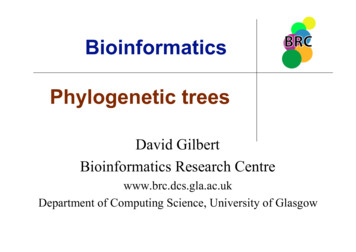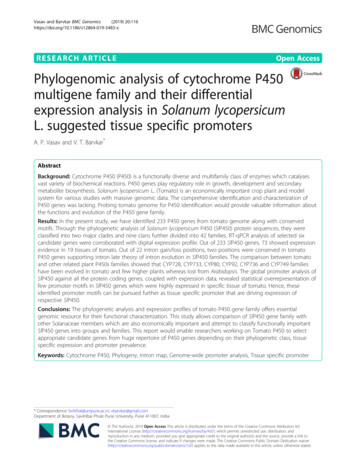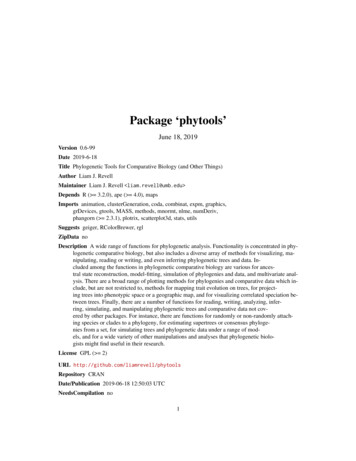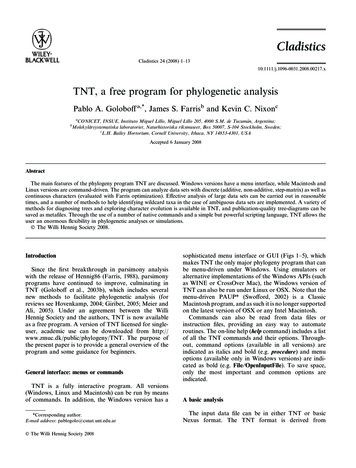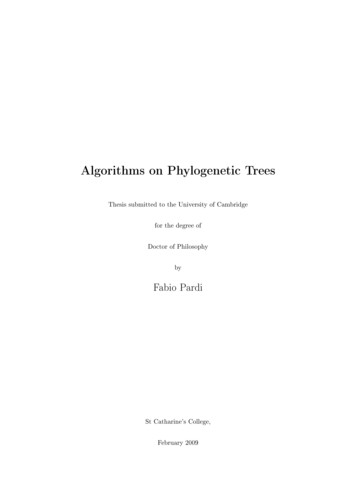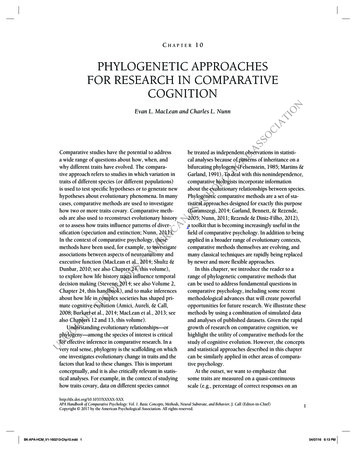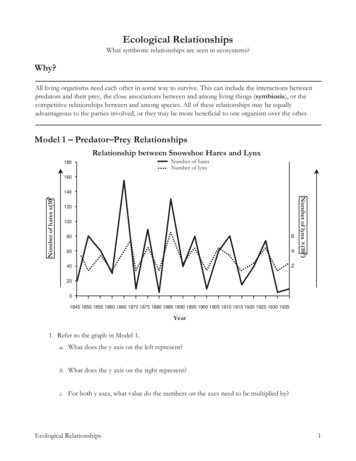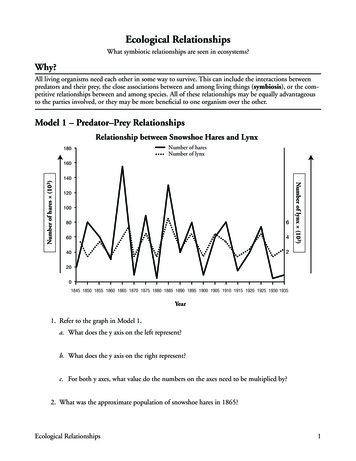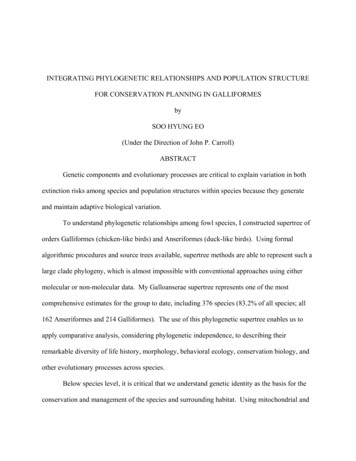
Transcription
INTEGRATING PHYLOGENETIC RELATIONSHIPS AND POPULATION STRUCTUREFOR CONSERVATION PLANNING IN GALLIFORMESbySOO HYUNG EO(Under the Direction of John P. Carroll)ABSTRACTGenetic components and evolutionary processes are critical to explain variation in bothextinction risks among species and population structures within species because they generateand maintain adaptive biological variation.To understand phylogenetic relationships among fowl species, I constructed supertree oforders Galliformes (chicken-like birds) and Anseriformes (duck-like birds). Using formalalgorithmic procedures and source trees available, supertree methods are able to represent such alarge clade phylogeny, which is almost impossible with conventional approaches using eithermolecular or non-molecular data. My Galloanserae supertree represents one of the mostcomprehensive estimates for the group to date, including 376 species (83.2% of all species; all162 Anseriformes and 214 Galliformes). The use of this phylogenetic supertree enables us toapply comparative analysis, considering phylogenetic independence, to describing theirremarkable diversity of life history, morphology, behavioral ecology, conservation biology, andother evolutionary processes across species.Below species level, it is critical that we understand genetic identity as the basis for theconservation and management of the species and surrounding habitat. Using mitochondrial and
nuclear microsatellite loci, I investigated intraspecific genetic relationships among northernbobwhites (Colinus virginianus). There was extremely high genetic differentiation betweenisolated Arizona northern bobwhites (masked bobwhite, C. v. ridgwayi) and the other subspecies(C. v. marilandicus, C. v. virginianus, C. v. floridanus, C. v. mexicanus, C. v. taylori, and C. v.texanus). Based on genetic structure and geographic ranges, my results suggest that each of C. v.ridgwayi and C. v. floridanus should be considered as a distinct unit for conservation ormanagement, supporting current subspecies limits. However, C. v. virginianus, C. v.marilandicus, C. v. mexicanus, and C. v. taylori may be considered a single management unitbecause levels of genetic divergence among these putative subspecies were quite low. Amongall analyzed subspecies, masked bobwhite has the lowest diversity in all genetic information.Therefore, it is highly recommended to set conservation priority to the masked bobwhites as anindependent conservation unit.INDEX WORDS:Supertree, Galloanserae, Anseriformes, Galliformes, Colinus virginianus,Population structure, Units for Conservation and management
INTEGRATING PHYLOGENETIC RELATIONSHIPS AND POPULATION STRUCTUREFOR CONSERVATION PLANNING IN GALLIFORMESbySOO HYUNG EOB.S., The Seoul National University, South Korea, 1999M.S., The Seoul National University, South Korea, 2001A Dissertation Submitted to the Graduate Faculty of The University of Georgia in PartialFulfillment of the Requirements for the DegreeDOCTOR OF PHILOSOPHYATHENS, GEORGIA2008
2008Soo Hyung EoAll Rights Reserved
INTEGRATING PHYLOGENETIC RELATIONSHIPS AND POPULATION STRUCTUREFOR CONSERVATION PLANNING IN GALLIFORMESbySOO HYUNG EOElectronic Version Approved:Maureen GrassoDean of the Graduate SchoolThe University of GeorgiaAugust 2008Major Professor:John P. CarrollCommittee:Michael J. ConroyDaniel E. L. PromislowJohn P. Wares
ACKNOWLEDGEMENTSMy wife, Eunyoung Cho, has been supportive of every aspect of me through these longyears, all while maintaining her job, keeping the household going, and taking care of ourdaughter, Jadu (Darby). This dissertation would not have been possible without herunconditional love and constant patience. Eunyoung’s and Jadu’s smile has provided motivationto finish this work. I love you, Eunyoung and Jadu. I also thank my mother and parents-in-lawfor being supportive even though I have stayed in school for much longer time than expected.I would like to acknowledge my committee members for their advice and patience. First,my advisor John P. Carroll took a chance on me as a graduate student and provided a greatsupport and environment for me. His encouragement and laughs kept me on track. John P.Wares was a constant source of information on population genetics and evolutionary biology.He also provided detailed editorial advice on the manuscripts. My other committee members,Michael J. Conroy and Daniel E. L. Promislow, helped me during written and oral exams, andcontributed to my dissertation research.For the supertree construction, I would like to thank Olaf, R. P. Bininda-Emonds forassistance and advice during all steps from project design to writing manuscript. I am grateful toAidan Keane for sharing his idea on comparative analysis and for providing his dataset ofGalliformes life history. I would like to thank B. Faircloth, C. J. Nairn, B. Shamblin, and T.Terhune for their assistance in completing molecular work.I am indebted to the following individuals for collecting northern bobwhite samples: R.Aguilar, B. Bass, A. Burnett, R. Chapman, J. Cook, R. Dimmick, B. Faircloth, B. Grossman, R.iv
vHamrick, D. L. Horner, G. Joyner, J. Martin, R. Pierson, L. Potter, B. Robinson, R. Rodgers, C.Sisson, A. Staphenson, R. Stonebraker, S. Taylor, R. Thackston, J. Thompson, M. Travis, T.Valentine, and E. Wehland. Sampling for my population genetics project would not have beenpossible without their generous cooperation.This dissertation work was funded by many sources: the University of Georgia, WarnellSchool of Forestry and Natural Resources, MacIntire-Stennis GEO-100 and 136, Bill TerrellResearch Grant and Branch Howe Jr. Research Grant of Georgia Ornithological Society, theNortheast Georgia, Augusta, and Albany Chapters of Quail Unlimited, Tall Timbers ResearchStation, and Land Conservancy, Inc. Thank you all.
TABLE OF CONTENTSPageACKNOWLEDGEMENTS . ivLIST OF TABLES . viiLIST OF FIGURES . ixCHAPTER1INTRODUCTION AND LITERATURE REVIEW .12A PHYLOGENETIC SUPERTREE OF THE FOWLS (GALLOANSERAE, AVES)123SUBSPECIES AND UNITS FOR CONSERVATION AND MANAGEMENT OFTHE NORTHERN BOBWHITE IN THE EASTERN UNITED STATES .624EXTREMELY HIGH OR TOO LOW GENETIC DIFFERENTIATION IN HIGHLYPOLYTYPIC WIDESPREAD NORTHERN BOBWHITES: CONGRUENT ORCONFLICTING PATTERNS IN MITOCHONDRIAL AND NUCLEARMICROSATELLITE LOCI .905CONCLUSIONS.138APPENDICESAThe rQS VALUES FOR THE STRICT CONSENSUS SUPERTREE, INDICATINGNODAL SUPPORT ( SE) AMONG THE SET OF SOURCE TREES .142BLIST OF ORIGINAL REFERENCES CONTAINING SOURCE TREES USED INTHE GALLOANSERAE SUPERTREE CONSTRUCTION .154vi
LIST OF TABLESPageTable 2.1: Information for major clades of Gallanserae, including number of taxa recognized andcovered in this study and summary statistics for the supertrees. .43Table 3.1: Northern Bobwhite (Colinus virginianus) collection sites (mapped in Figure 4.1),genetic polymorphism, and hypotheses of demographic history for different subspeciesor populations, based on mtDNA CR sequences. .82Table 3.2: Pairwise FST (below diagonal) and the significance of Exact tests of differentiation(above diagonal) among the northern bobwhite subspecies in the study area, based onmtDNA control region. .84Table 3.3: Analysis of molecular variance in the northern bobwhites with several a priorigrouping scenarios, based on putative subspecies. .85Table 4.1: Northern Bobwhite (Colinus virginianus) collection sites (mapped in Figure 5.1) anddescriptive genetic diversity data of each local populations based on mtDNA controlregion sequences and 16 multilocus microsatellite loci. Total number of individualsanalyzed (NT), number of mtDNA-sequenced individuals (nmt), number of mtDNAhaplotypes (nh), haplotype (h) and nucleotide (π) diversities ( standard deviation, SD),number of genotyped individuals (nmic), mean number of alleles per locus (A), allelicrichness (AC), observed (HO) and expected (HE) heterozygosities ( SD). .125Table 4.2: Pairwise values of FST (mtDNA; above the diagonal) and RST (microsatellites; belowthe diagonal) among populations (with seven or more individuals per population) ofvii
viiinorthern bobwhites. * indicates significant (P 0.05) pairwise FST or RST, and valuesin bold are significant after sequential Bonderroni correction. NA, not available .127Table 4.3: Analysis of molecular variance (AMOVA) for the northern bobwhites. Samples werepartitioned with several a priori grouping scenarios, based on putative subspeciesand/or geographic distribution. .128Table 4.4: Population structure inferred by spatial analysis of molecular variance (SAMOVA)based on northern bobwhite mtDNA haplotypes. Best results for each pre-definednumber of groups K 2 to 5 are shown. .129
LIST OF FIGURESPageFigure 2.1: Temporal distribution of source trees included in the Galloanserae supertree .44Figure 2.2: Partial representation of the Galloanserae supertree, showing interrelationships of andrelative species richness of the major higher-level groups. Numbers on nodesrepresent node IDs (see Appendix A) .45Figure 2.3: Component Component supertrees of the fowl supertree showing species-levelrelationships: A) Galloanserae, B) Anatidae, C) Anatinae I, D) Anatinae II, E)Anatinae III, F), Tadorinae, G) Anas, H) Anserinae, I) Megapodiidae, J) Numididae,K) Odontophoridae, L) Phasianidae II, M) Phasianinae I, N) Phasianinae II, O)Perdicinae I, and P) Tetraoninae. .46Figure 3.1: Sample populations and putative subspecies of the northern bobwhites in this study.See the Table 4.1 for population acronyms and sample sizes. .86Figure 3.2: A Median-joining network for 41 haplotypes of the northern bobwhites. The relativesizes of the circles represent the number of individuals contained within eachhaplotype, and the pie slices represent the portion of each subspecies (open, C. v.marilandicus; hatched, C. v. virginianus; black, C. v. floridanus; gray, C. v.mexicanus) .87Figure 3.3: Genetic distance, FST / (1 FST), based on mtDNA control region versus geographicdistances, km, for all pairwise combinations of 14 northern bobwhite populations. Aix
xsignificant positive correlation was observed (y 0.0001x 0.062, r 0.37, P 0.0056, 30 000 randomizations, Mantel test) .88Figure 3.4: Mismatch distributions for all pooled samples and four putative subspecies of thenorthern bobwhites. The observed distributions (bars) were compared with expecteddistributions under a model of sudden expansion (black circles and solid lines). Pvalues were calculated as the proportion of simulations producing a larger sum-ofsquared deviation (SSD) than the observed SSD .89Figure 4.1: Map of sampling populations across the entire subspecies range for northernbobwhites in the USA: 1, New York (NY); 2, New Jersey (NJ); 3, Eastern Virginia(VAe); 4, Southern Virginia (VAs); 5, North Carolina (NC); 6, South Carolina (SC); 7,Florida-Georgia (FLGA); 8, Central Florida (FLc); 9, Southern Florida (FLs); 10,Indiana (IN); 11, Illinois (IL); 12, Central Kentucky (KYc); 13, Eastern Kentucky(KYe); 14, Kentucky-Tennessee (KYTN); 15, Mississippi-Tennessee (MSTN); 16,Tennessee (TN); 17, Texas (TX); 18, Iowa (IA); 19, Nebraska (NE); 20, Missouri(MO); 21, Central Kansas (KSc); 22, Eastern Kansas (KSe); 23, Kansas-Oklahoma(KSOK); 24, Oklahoma-Texas (OKTX); 25, Arizona (AZ) .130Figure 4.2: Bayesian inference in northern bobwhite mtDNA control region haplotypes (H1 toH60), computed using TrN I G genetic substitution model. Bayesian posteriorprobabilities are given above the branches. The table on the right shows thedesignated subspecies of these haplotypes (rid C. v. ridgwayi; flo C. v. floridanus;vir C. v. virginianus; mex C. v. mexicanus; mar C. v. marilandicus; tex C. v.texanus; tay C. v. taylori) .131
xiFigure 4.3: A median-joining network for 60 haplotypes of the northern bobwhites. The relativesizes of the circles represent the number of individuals contained within eachhaplotype which is indicated by numbers. Line lengths reflect actual branch lengthsbetween haplotypes .133Figure 4.4: Genetic distance based on (a) mtDNA control region, FST /(1 FST), or (b)microsatellite data, RST /(1 RST), versus geographic distances, km, for pairwisecombinations of northern bobwhite populations (excluding an isolated Arizonapopulation).134Figure 4.5: Log posterior probability of the microsatellite data for a given number of simulatedcluster K, Ln Pr(X K) with standard error (across five independent runs) and the rate ofchange in the posterior probability, ΔK, computed by STRUCTURE (under the'admixture and correlated allele frequencies among populations' model), using theMCMC with 1 million repetitions for each run .135Figure 4.6: Proportion of the memberships for northern bobwhite individuals inferred withSTRUCTURE v.2.2.3 and poltted with DISTRUCT v.1.1 without using priorpopulation definitions. Each individual is represented by a vertical line partitionedinto K 2, 3, 4, and 5 clusters, respectively. Each color represents a different clusterand black lines separate the individuals of different geographically sampledpopulations .136Figure 4.7: Factorial component analysis of northern bobwhite genotypes, computed by GENETIX using16 microsatellite loci. FC-I and FC-II are the first two factorial components, explaining 41.5%and 21.3%, respectively, of the variation at the subspecies level .137
CHAPTER 1INTRODUCTION AND LITERATURE REVIEWGlobal biodiversity currently faces an extinction crisis at an alarming rate that is unprecedented(Novacek and Cleland 2001; Pimm et al. 1995). About 20% of mammalian and 12% of avianspecies are listed by IUCN as threatened with extinction (IUCN 2007). At the population level,it is estimated that annually 1% of habitats and populations are currently losing (Balmford et al.2003; Hughes et al. 1997). However, not all populations, species, or lineages are equally likelyto be threatened and to become extinct. Some species are much more likely to become extinctthan others. For example, avian families such as parrots (Psittacidae), albatrosses (Procellaridae),and pheasants (Phasianidae) have significantly more threatened species than expected by chance,whereas families such as woodpeckers (Picidae) and cuckoos (Cuculidae) have significantlyfewer threatened species (Bennett and Owens 1997; IUCN 2007). This suggests that threatenedtaxa tend to be more closely related to one another in their clades and that loss of evolutionarydiversity tends to be made worse in those clades (Purvis et al. 2000a). Even within species,declining populations have been more often found at range margins and in fragmented patchesthan within central populations with continuous ranges, thereby also exhibiting low geneticdiversity and greater genetic differentiation (Channell and Lomolino 2000; Eckert et al. 2008).In this context, many researchers have argued that vulnerability to extinction of species or localpopulations may be commonly associated with not only human-induced direct threats tobiodiversity, but also demographic or ecological aspects, such as small population size and high1
habitat specificity (e.g., Johnson et al. 2002; MacArthur and Wilson 1967; Owens and Bennett2000; Purvis et al. 2000b), and evolutionarily adaptive or genetic traits such as large body size,slow reproductive rates and low genetic variability that make species susceptible to extinction(e.g., Bennett and Owens 1997; Frankham et al. 2002; Keane et al. 2005; Long et al. 2007; Priceand Gittleman 2007).Genetic components and evolutionary processes are critical to explain variation in bothextinction risks among species and population structures within species because they generateand maintain adaptive biological variation (Avise 2000; Futuyma 2005; Mace and Purvis 2008;Norris and Pain 2002). It is important to retain the ability for taxa to adapt to new environmentsin a rapidly changing world (Mace and Purvis 2008). Consequently, efficient and systematicconservation efforts have to incorporate both ecological and evolutionary processes (Rouget et al.2006). After recognizing the importance of genetic components and evolutionary processes, aswell as ecological importance, the next practical step in conservation biology is delineating‘units’ of biodiversity (Moritz 1994; Ryder 1986). Traditionally, species is the basic unit ofinterest in conservation biology (Agapow et al. 2004; Barraclough and Nee 2001), thereforedelineating and identifying species is important to design species-specific conservation andmanagement. In this respect, a well-resolved phylogenetic structure can provide a basis when weselect specific species as units for conservation action. However, the scale of conservationefforts may vary; conservation biologists not only target a specific species, but also restoreimportant habitats and populations at local scales and protect widespread species, genera, andfamilies at global scales (Norris and Pain 2002). Given that we do not have time, man-power,and finances enough to undertake conservation efforts for all taxa, setting conservation prioritiesand correctly allocating limited conservation resources should be based on comparison of the2
relative importance of all possible conservation units (Fisher and Owens 2004; Purvis et al.2000c). In my dissertation, I describe phylogenetic relationships among species and intraspecificpopulation structures for conservation planning in Galliformes, integrating macro- and microlevel molecular ecology, evolutionary genetics, and applications to the conservation biology ofthis avian group.In the first part (Chapters 2) of my dissertation, focusing on macro-level evolution andconservation biology, I construct phylogenetic supertree of orders Galliformes (chicken-likebirds) and Anseriformes (duck-like birds). Based on this phylogenetic relationship, we mayillustrate life history, ecological, and anthropogenic correlates of extinction risk in Galliformes.The Galloanserae (Galliformes and Anseriformes), comprising about 450 species withremarkable diversity of their life history traits, presents an exceptional group for studying a widerange of ecology, evolutionary biology, and conservation biology (del Hoyo et al. 1992, 1994;Dickinson 2003). Although much phylogenetic information has been presented in theGalloanserae (e.g., Armstrong et al. 2001; Birks and Edwards 2002; Crowe et al. 1992; Dimcheffet al. 2002; Donne-Gousse et al. 2002; Drovetski 2002; Livezey 1986, 1991, 1996; Pereira et al.2002), thus far genus-level relationships have been functioned as the most detailed phylogeniesfor this group (e.g., Crowe et al. 2006; Livezey 1997). Using formal algorithmic procedures andsource trees available, supertree methods are able to represent such a large clade phylogeny,which is almost impossible with conventional approaches using either molecular or nonmolecular data (Bininda-Emonds et al. 2004; Sanderson et al. 2003). In Chapter 2, I constructspecies-level phylogenetic relationships of the Galloanserae using the supertree approach.Comparative methods are frequently applied to testing hypotheses on adaptations andother evolutionary phenomena (Futuyma 2005). However, it is not appropriate to treat values of3
traits from closely related species as independent because such traits are often shared throughcommon descent rather than independent evolution (Felsenstein 1985; Harvey and Pagel 1991).The use of Galliformes phylogenetic supertrees enables us to apply comparative analysis,considering phylogenetic independence, to describing their remarkable diversity of life history,morphology, behavioral ecology, and other evolutionary processes across species.At the micro-level of molecular ecology, the second part (Chapters 3 and 4) of mydissertation addresses subspecies-level phylogenetic relationships and patterns of geneticpopulation structure in a species, Northern Bobwhite Colinus virginianus, using mitochondrialand nuclear genome analyses. The species, widely distributed in the North America, is currentlyundergoing population declines throughout most of its native geographic range (Brennan 1999;Burger 2002; Carroll 1994; Johnsgard 1988). However, we lack basic information on theirintraspecific systematics and genetic structure of populations. Although most conservationbiologists believe that genetically differentiated populations within species (such asevolutionarily significant units or management units) require separate genetic management(Crandall et al. 2000; Moritz 1994; Palsboll et al. 2007), many introductions and translocationsof northern bobwhites have been undertaken, without genetic consideration, for the purpose ofrecovery from population decline (see references in Scott 1985). It is critical that we understandtheir genetic identity as the basis for the conservation and management of the species andsurrounding habitat. In Chapter 3, I investigate intraspecific genetic relationships among fourputative northern bobwhite subspecies (C, v. marilandicus, C. v. virginianus, C. v. mexicanus,and C. v. floridanus) in the eastern United States, using mitochondrial DNA control regionsequences. Also, I examine if populations have experienced recent demographic expansion andcolonization processes.4
Despite its relative abundance and widespread distribution of northern bobwhites,northern bobwhite has been listed as “Near Threatened” by the IUCN since 2001 (IUCN 2007).Particularly, one subspecies (masked bobwhite C. v. ridgwayi) is listed under the EndangeredSpecies Act of 1973 (USFWS 1995). In fact, this subspecies is geographically isolated andrestricted to only one reintroduced population in Arizona, with population of only 1000 – 2000individuals (Carroll 1994; Hernandez et al. 2006; Kuvlesky et al. 2000). However, we have littleinformation on if northern bobwhites including this endangered subspecies have high levels ofgenetic diversity, are connected with adjacent or related populations, or are genetically managedas some separate units for conservation. In Chapter 4, I employ both mitochondrial and nuclearmicrosatellite loci to examine patterns and levels of genetic differentiation for northern bobwhitepopulations and to describe possible factors responsible for shaping variable genetic structuresacross widespread or isolated populations in the species.Finally, in Chapter 5, I summarize integrative conclusion that can not only contribute topure natural science itself, but also act as a powerful tool for directing effective conservationplanning and management implications for this avian group.REFERENCESAgapow, P.-M., Bininda-Emonds, O.R.P., Crandall, K.A., Gittleman, J.L., Mace, G.M., Marshall,J.C., Purvis, A., 2004. The impact of species concept on biodiversity studies. QuarterlyReview of Biology 79, 161-179.Armstrong, M.H., Braun, E.L., Kimball, R.T., 2001. Phylogenetic utility of avian ovomucoidintron G: a comparison of nuclear and mitochodrial phylogenies in Galliformes. Auk 118,799-804.5
Avise, J.C., 2000. Phylogeography: the history and formation of species. Harvard UniversityPress, Cambridge.Balmford, A., Green, R.E., Jenkins, M., 2003. Measuring the changing state of nature. Trends inEcology and Evolution 18, 326-330.Barraclough, T.G., Nee, S., 2001. Phylogenetics and speciation. Trends in Ecology andEvolution 16, 391-399.Bennett, P.M., Owens, I.P.F., 1997. Variation in extinction-risk among birds: chance orevolutionary predisposition? Proceedings of the Royal Society B 264, 401-408.Bininda-Emonds, O.R.P., Gittleman, J.L., Steel, M.A., 2004. The supertree of life: procedures,problems, and prospects. Annual Review of Ecology and Systematics 33, 265-289.Birks, S.M., Edwards, S.V., 2002. A phylogeny of the megapodes (Aves: Megapodiidae) basedon nuclear and mitochondrial DNA sequences. Molecular Phylogenetics and Evolution23, 408-421.Brennan, L.A., 1999. Northern Bobwhite (Colinus virginianus), In The Birds of North America.eds A. Poole, F. Gill. The Birds of North America, Inc., Philadelphia.Burger, L.W., 2002. Quail management: issues, concerns, and solutions for public and privatelands - a southeastern perspective, In Quail V: The 5th National Quail Symposium. edsS.J. DeMaso, W.P.J. Kuvlesky, F. Hernandez, M.E. Berger, pp. 20-34. Texas Parks andWildlife Department, Austin, TX.Carroll, J.P., 1994. Family Odontophoridae (New World quails). In Handbook of the Birds of theWorld. eds J. del Hoyo, A. Elliott, J. Sargatal, pp. 412-433. Lynx Ediciones, Barcelona.6
Channell, R., Lomolino, M.V., 2000. Dynamic biogeography and conservation of endangeredspecies. Nature 403, 84-86.Crandall, K.A., Bininda-Emonds, O.R.P., Mace, G.M., Wayne, R.K., 2000. Consideringevolutionary processes in conservation biology. Trends in Ecology and Evolution 15,290-295.Crowe, T.M., Bowie, R.C.K., Bloomer, P., Mandiwana, T.G., Hedderson, T.A.J., Randi, E.,Pereira, S.L., Wakeling, J., 2006. Phylogenetics, biogeography and classification of, andcharacter evolution in, gamebirds (Aves: Galliformes): effects of character exclusion,data partitioning and missing data. Cladistics 22, 495-532.Crowe, T.M., Harley, E.H., Jakutowicz, M.B., Komen, J., Crowe, A.A., 1992. Phylogenetic,taxonomic and biogeographical implications of genetic, morphological, and behavioralvariation in Francolins (Phasianidae: Francolinus). Auk 109, 24-42.del Hoyo, J., Elliott, A., Sargatal, J., 1992. Handbook of the Birds of the World. Vol. 1. LynxEdiciones, Barcelona.del Hoyo, J., Elliott, A., Sargatal, J., 1994. Handbook of the Birds of the World. Vol. 2. LynxEdiciones, Barcelona.Dickinson, E.C., 2003. The Howard and Moore Complete Checklist of the Birds of the World, 3edn. Christopher Helm, London.Dimcheff, D.E., Drovetski, S.V., Mindell, D.P., 2002. Phylogeny of Tetraoninae and othergalliform birds using mitochondrial 12S and ND2 genes. Molecular Phylogenetics andEvolution 24, 203-215.7
Donne-Gousse, C., Laudet, V., Hanni, C., 2002. A molecular phylogeny of anseriformes basedon mitochondrial DNA analysis. Molecular Phylogenetics and Evolution 23, 339-356.Drovetski, S.V., 2002. Molecular phylogeny of grouse: individual and combined performance ofW-linked, autosomal, and mitochondrial loci. Systematic Biology 51, 930-945.Eckert, C.G., Samis, K.E., Lougheed, S.C., 2008. Genetic variation across species’ geographicalranges: the central-marginal hypothesis and beyond. Molecular Ecology 17, 1170-1188.Felsenstein, J., 1985. Phylogenies and the comparative method. The American Naturalist 125, 115.Fisher, D.O., Owens, I.P.F., 2004. The comparative method in conservation biology. Trends inEcology and Evolution 19, 391-398.Frankham, R., Ballou, J.D., Briscoe, D.A., 2002. Introduction to Conservation Genetics.Cambridge University Press, Cambridge.Futuyma, D.J., 2005. Evolution. Sinauer, Sunderland.Harvey, P.H., Pagel, M.D., 1991. The comparative method in evolutionary biology. OxfordUniversity Press, Oxford.Hernandez, F., Kuvlesky, W.P.J., DeYoung, R.W., Brennan, L.A., Gall, S.A., 2006. Recovery ofrare species: case study of the masked bobwhite. Journal of Wildlife Management 70,617-631.Hughes, J.B., Daily, G.C., Ehrlich, P.H., 1997. Population diversity: its extent and extinction.Science 278, 689-692.IUCN, 2007. 2007 IUCN Red List of Threatened Species. www.iucnredlist.org.8
Johnsgard, P.A., 1988. The Quails, Partridges, and Francolins of the World. Oxford UniversityPress, Oxford.Johnson, C.N., Delean, S., Balmford, A., 2002. Phylogeny and the selectivity of extinction inAustralian marsupials. Animal Conservation 5, 135-142.Keane, A., Brooke, M.d.L., Mcgowan, P.J.K., 2005. Correlates of extinction risk and huntingpressure in gamebirds (Galliformes). Biological Conservation 126, 216-233.Kuvlesky, W.P.J., Gall, S.A., Dobrott, S.J., Tolley, S., Guthery, F.S., DeStefano, S.A., King, N.,Nolte, K.R., Silvy, N.J., Lewis, J.C., Gee, G., Camou, L.G., Engel-Wilson, R., 2000. Thestatus of endangered masked bobwhite recovery in
conservation and management of the species and surrounding habitat. Using mitochondrial and . . their genetic identity as the basis for the conservation and management of the species and surrounding habitat. In Chapter 3, I investigate intraspecific genetic relationships among four . North Carolina (NC) 28 12 0.897 0.031 0.34 0.22 2 .
